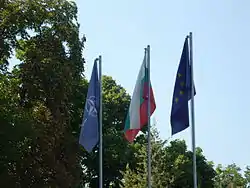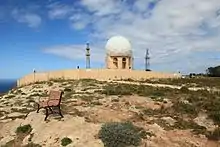Enlargement of NATO
Enlargement of the North Atlantic Treaty Organization (NATO) is the process of including new member states in NATO. NATO is a military alliance of twenty-eight European and two North American countries that constitutes a system of collective defense. The process of joining the alliance is governed by Article 10 of the North Atlantic Treaty, which allows only for the invitation of "other European States", and by subsequent agreements. Countries wishing to join have to meet certain requirements and complete a multi-step process involving political dialogue and military integration. The accession process is overseen by the North Atlantic Council, NATO's governing body.
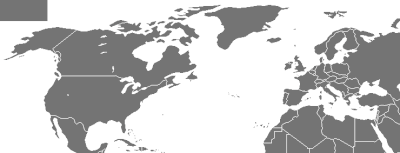
After its formation in 1949 with twelve founding members, NATO grew by including Greece and Turkey in 1952 and West Germany in 1955, and then later Spain in 1982. After the Cold War ended, and Germany reunited in 1990, there was a debate in NATO about continued expansion eastward. In 1999, Poland, Hungary, and the Czech Republic joined NATO, amid much debate within the organization and Russian opposition. Another expansion came with the accession of seven Central and Eastern European countries: Bulgaria, Estonia, Latvia, Lithuania, Romania, Slovakia, and Slovenia. These nations were first invited to start talks of membership during the 2002 Prague summit, and joined NATO shortly before the 2004 Istanbul summit. Albania and Croatia joined on 1 April 2009, prior to the 2009 Strasbourg–Kehl summit. The most recent member states to be added to NATO are Montenegro on 5 June 2017 and North Macedonia on 27 March 2020.
As of 2020, NATO officially recognizes Bosnia and Herzegovina as an official candidate and two aspiring members: Georgia and Ukraine. Future expansion is currently a topic of debate in several countries outside the alliance, and countries like Sweden, Finland, and Serbia have open political debate on the topic of membership, while in countries like Ukraine, support and opposition to membership is tied to ethnic and nationalist ideologies. The incorporation of countries formerly part of the Eastern Bloc and the Soviet Union has been a cause of increased tension between NATO countries and Russia.
Past enlargements
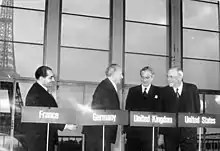
NATO has added new members eight times since its founding in 1949 to include thirty members. Twelve countries were part of the founding of NATO: Belgium, Canada, Denmark, France, Iceland, Italy, Luxembourg, the Netherlands, Norway, Portugal, the United Kingdom, and the United States. The early years of the Cold War saw a stark divide between Capitalist states, backed by United States, and Communist satellite states of the Soviet Union. This divide eased inclusion of Portugal under Antonio Salazar in NATO and encouraged the anti-Communist governments of Greece and Turkey to join NATO in 1952. Greece would suspend its membership in 1974, over the Turkish invasion of Cyprus, but rejoined in 1980 with Turkey's cooperation.[1]
The Bonn–Paris conventions ended the allies' occupation of West Germany, and were ratified in part on the condition that West Germany join NATO, which it did in 1955.[2] Though initially isolationist, Spain under Francisco Franco was staunchly anti-Communist, and bound by regular defence agreements with NATO countries.[3] After its transition to democracy, Spain came under pressure to normalize its European relations, including joining NATO, which it did in 1982. A referendum in 1986 confirmed popular support for this.[4]
German reunification and relations with Russia
The first post-Cold War expansion of NATO came with German reunification on 3 October 1990, when the former East Germany became part of the Federal Republic of Germany and the alliance. This had been agreed in the Two Plus Four Treaty earlier in the year. To secure Soviet approval of a united Germany remaining in NATO, it was agreed that foreign troops and nuclear weapons would not be stationed in the former East Germany, and the topic of further NATO expansion east was raised.[5] There is no mention of NATO enlargement in the September–October 1990 agreements on German reunification, so there was no formal commitment not to expand.[6][7]
NATO enlargement became a controversial topic again in 2010's with Russia's actions in Ukraine. Whether or not the West informally committed to not enlarge NATO to the East is a matter of dispute among historians and international relations scholars.[6]
Harvard University historian Mark Kramer rejects that an informal agreement existed,[6][8] whereas Texas A&M University political scientist Joshua R. Itzkowitz Shifrinson and Professor Marc Trachtenberg of University of California, Berkeley, both argue that an informal agreement existed.[6][7][9] In December 2017, Svetlana Savranskaya and Tom Blanton of the National Security Archive at George Washington University argued that newly declassified documents showed that an informal agreement existed.[10][11] During August 1993 visit to Poland president Boris Yeltsin declared to president Lech Wałęsa that "Russia does not oppose Poland's membership in NATO and does not perceive its membership in NATO as a threat to Russia". Under pressure from opposition in Russia, this informal declaration was retracted in September by the president Yeltsin's office.[12]
Jack Matlock, US ambassador to the Soviet Union during its final years, said that the West gave a "clear commitment" not to expand, and declassified documents indicate that Soviet negotiators were given the oral impression by diplomats like Hans-Dietrich Genscher and James Baker that NATO membership was off the table for countries such as Czechoslovakia, Hungary, or Poland.[13][7] In 1996, Gorbachev wrote in his Memoirs, that "during the negotiations on the unification of Germany they gave assurances that NATO would not extend its zone of operation to the east,"[14] and repeated this view in an interview in 2008.[15] However, in 2014, Gorbachev said "The topic of 'NATO expansion' was not discussed at all [in 1990], and it wasn't brought up in those years. I say this with full responsibility. Western leaders didn't bring it up, either."[6][16] Eduard Shevardnadze, foreign minister of the Soviet Union between 1985 and 1991, has always maintained that "NATO's expansion beyond German borders never came up for negotiation."[6] According to Robert Zoellick, a State Department official involved in the Two Plus Four negotiating process, no formal commitment regarding enlargement was made.[17]
Central and Eastern Europe
Central and Eastern European countries pushed for NATO enlargement, driven primarily by Russia's actions domestically (First Chechen War) and internationally (Transnistria War, War in Abkhazia) as well as calls for restoration of the USSR,[18] which were all perceived as neo-imperialist and serious concern for countries that had memories of similar Soviet offensives.[19] Political parties reluctant to move on NATO membership, such as the Bulgarian Socialist Party and Slovak HZDS, were voted out of office.[20] Hungary's interest in joining was confirmed by a November 1997 referendum that returned 85.3 percent in favor of membership,[21] similarly Poland with over 80% support.[22]
Visegrád Group

In February 1991, Poland, Hungary, and Czechoslovakia formed the Visegrád Group to push for European integration under the European Union and NATO, as well as to conduct military reforms in line with NATO standards. Internal NATO reaction to these former Warsaw Pact countries was initially negative, but by the 1991 Rome summit in November, members agreed to a series of goals that could lead to accession, such as market and democratic liberalization, and that NATO should be a partner in these efforts. In subsequent years, wider forums for regional cooperation between NATO and its eastern neighbors were set up, including the North Atlantic Cooperation Council (later the Euro-Atlantic Partnership Council) and the Partnership for Peace.[23]
While the other Visegrád members were invited to join NATO at its 1997 Madrid summit, Slovakia was excluded based on what several members considered undemocratic actions by nationalist Prime Minister Vladimír Mečiar.[24] Romania and Slovenia were both considered for invitation in 1997, and each had the backing of a prominent NATO member, France and Italy respectively, but support for enlargement was not unanimous, particularly in the US Congress.[25] In an open letter to US President Bill Clinton, more than forty foreign policy experts including Bill Bradley, Sam Nunn, Gary Hart, Paul Nitze, and Robert McNamara expressed their concerns about NATO expansion as both expensive and unnecessary given the lack of an external threat from Russia at that time.[26]
A 2006 study in the journal Security Studies argued that the NATO enlargements in 1999 and 2004 contributed to democratic consolidation in Central and Eastern Europe.[27]
Vilnius Group
Shortly after the fall of the Berlin wall in 1989, the George H.W. Bush administration (1989-1993) began to debate internally whether enlargement of NATO was feasible and desirable.[28] By mid-1992, a consensus emerged within the administration that NATO enlargement was a wise realpolitik measure to strengthen American hegemony.[28][29] In the absence of NATO enlargement, Bush administration officials worried that the European Union might fill the security vacuum in Eastern Europe, and thus challenge American post-Cold War influence.[28] There was an active debate within the Clinton administration (1993-2001) between a rapid offer of full membership to several select countries verses a slower, more limited membership to a wide range of states over a longer time span. Victory by the Republican Party, who advocated for aggressive expansion, in the 1994 U.S. congressional election helped sway U.S. policy in favor of wider full-membership enlargement.[30]
At the 1999 Washington summit, where Hungary, Poland, and the Czech Republic officially joined, NATO also issued new guidelines for membership with individualized "Membership Action Plans" for Albania, Bulgaria, Estonia, Latvia, Lithuania, North Macedonia, Romania, Slovakia, and Slovenia.[31] In May 2000, these countries joined with Croatia to form the Vilnius Group in order to cooperate and lobby for common NATO membership, and by the 2002 Prague summit seven were invited for membership, which took place at the 2004 Istanbul summit.[32] Russia was particularly upset with the addition of the three Baltic states, the first countries that were part of the Soviet Union to join NATO.[33][32]
Adriatic Charter
Croatia also started a Membership Action Plan at the 2002 summit, leading to a national debate on whether a referendum on NATO membership needed to be held there. Croatian Prime Minister Ivo Sanader ultimately agreed in January 2008, as part of forming a coalition government with the HSS and HSLS parties, not to officially propose one.[34] Montenegro declared independence on 3 June 2006, and the new country subsequently joined the Partnership for Peace programme at the 2006 Riga summit. Albania and Croatia were invited to join NATO at the 2008 Bucharest summit that April, though Slovenia threatened to hold up Croatian membership over their border dispute in the Bay of Piran.[35] Slovenia did ratify Croatia's accession protocol in February 2009,[36] and Croatia and Albania both officially joined NATO just prior to the 2009 Strasbourg–Kehl summit, with little opposition from Russia.[37]
Montenegro applied for a Membership Action Plan on 5 November 2008,[38] which was granted in December 2009.[39] Montenegro also began full membership with the Adriatic Charter of NATO aspirants in May 2009.[40][41] On 2 December 2015, NATO formally invited Montenegro to join the alliance,[42] with negotiations concluding in May 2016.[43] Montenegro formally joined NATO on 5 June 2017.[44]
North Macedonia joined the Partnership for Peace in 1995, and commenced its Membership Action Plan in 1999, at the same time as Albania. At the 2008 Bucharest summit, Greece blocked a proposed invitation because it believed that its neighbor's constitutional name implies territorial aspirations toward its own region of Greek Macedonia. NATO nations agreed that the country would receive an invitation upon resolution of the Macedonia naming dispute.[45] Macedonia sued Greece at the International Court of Justice (ICJ) over their veto of Macedonia's NATO membership. Macedonia was part of the Vilnius Group, and had formed the Adriatic Charter with Croatia and Albania in 2003 to better coordinate NATO accession.[46] On 12 June 2017, Prime Minister Zoran Zaev signaled he would consider alternatives names for the country in order to strike a compromise with Greece, settle the naming dispute, and lift Greek objections to Macedonia joining the alliance. The naming dispute was resolved with the Prespa Agreement in June 2018 under which the country adopted the name North Macedonia, which was supported by a referendum in September 2018. NATO invited North Macedonia to begin membership talks on 11 July 2018,[47] and formal accession talks began on 18 October 2018.[48] NATO's members signed North Macedonia's accession protocol on 6 February 2019,[49] and most countries ratified the accession treaty in 2019, with Spain ratifying its accession protocol in March 2020.[50] The Sobranie also ratified the treaty unanimously on 11 February 2020.[51] North Macedonia eventually became a NATO member state on 27 March 2020.[52][53]
| Date | Country | Enlargement | 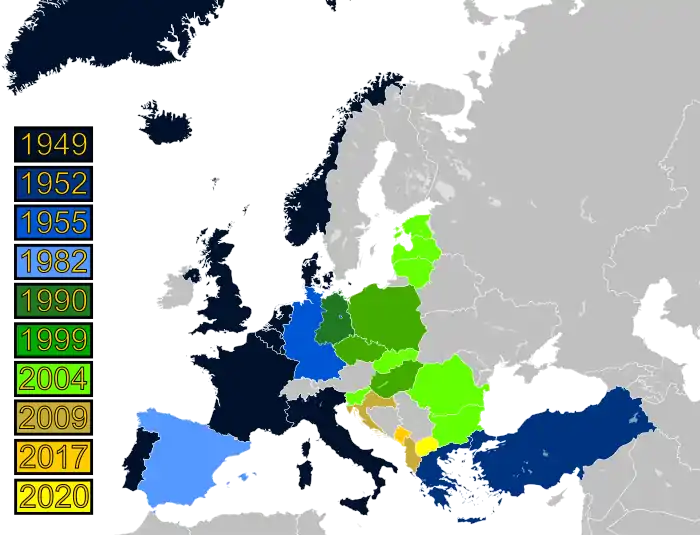 |
|---|---|---|---|
| 18 February 1952 | First | ||
| 9 May 1955 | Second | ||
| 30 May 1982 | Third | ||
| 3 October 1990 | German reunification | ||
| 12 March 1999 | Fourth | ||
| 29 March 2004 | Fifth | ||
| 1 April 2009 | Sixth | ||
| 5 June 2017 | Seventh | ||
| 27 March 2020 | Eighth | ||
Criteria and process
Article 10
The North Atlantic Treaty is the basis of the organization, and, as such, any changes including new membership requires ratification by all current signers of the treaty. The treaty's Article 10 describes how non-member states may join NATO, and outlines NATO's "open door" policy:
The Parties may by unanimous agreement, invite any other European State in a position to further the principles of this Treaty and to contribute to the security of the North Atlantic area to accede to this Treaty. Any State so invited may become a Party to the Treaty by depositing its instrument of accession with the Government of the United States of America. The Government of the United States of America will inform each of the Parties of the deposit of each such instrument of accession.[54]
This article poses two general limits to non-member states. First, only European states are eligible for new membership, and second, these states not only need the approval of all the existing member states, but every member state can put some criteria forward that have to be attained. In practice, NATO formulates a common set of criteria, but for instance Greece blocked the Republic of Macedonia's accession to NATO for many years due to the disagreement over the use of the name Macedonia. Turkey similarly opposes the participation of the Republic of Cyprus with NATO institutions as long as the Cyprus dispute is not resolved.[55]
Since the 1991 Rome summit, when the delegations of its member states officially offered cooperation with Europe's newly democratic states, NATO has addressed and further defined the expectations and procedure for adding new members. The 1994 Brussels Declaration reaffirmed the principles in Article 10 and led to the "Study on NATO Enlargement". Published in September 1995, the study outlined the "how and why" of possible enlargement in Europe,[56] highlighting three principles from the 1949 treaty for members to have: "democracy, individual liberty, and rule of law".[57]
As NATO Secretary General Willy Claes noted, the 1995 study did not specify the "who or when,"[58] though it discussed how the then newly formed Partnership for Peace and North Atlantic Cooperation Council could assist in the enlargement process,[59] and noted that on-going territorial disputes could be an issue for whether a country was invited.[60] At the 1997 Madrid summit, the heads of state of NATO issued the "Madrid Declaration on Euro-Atlantic Security and Cooperation" which invited three Eastern European countries to join the alliance, out of the twelve that had at that point requested to join, laying out a path for others to follow.[56]
Membership Action Plan
The biggest step in the formalization of the process for inviting new members came at the 1999 Washington summit when the Membership Action Plan (MAP) mechanism was approved as a stage for the current members to regularly review the formal applications of aspiring members. A country's participation in MAP entails the annual presentation of reports concerning its progress on five different measures:[61]
- Willingness to settle international, ethnic or external territorial disputes by peaceful means, commitment to the rule of law and human rights, and democratic control of armed forces
- Ability to contribute to the organization's defence and missions
- Devotion of sufficient resources to armed forces to be able to meet the commitments of membership
- Security of sensitive information, and safeguards ensuring it
- Compatibility of domestic legislation with NATO cooperation
NATO provides feedback as well as technical advice to each country and evaluates its progress on an individual basis.[62] Once a country is agreed to meet the requirements, NATO can issue that country an invitation to begin accession talks.[63] Currently, one country has a Membership Action Plan: Bosnia and Herzegovina,[64] but Georgia and Ukraine also want a MAP. Former MAP participants were Albania and Croatia between May 2002 and April 2009, Montenegro between December 2009 and June 2017 and North Macedonia between April 1999 and March 2020, when they joined NATO. The final accession process, once invited, involves five steps leading up to the signing of the accession protocols and the acceptance and ratification of those protocols by the governments of the current NATO members.[65]
Intensified Dialogue
Intensified Dialogue was first introduced in April 2005 at an informal meeting of foreign ministers in Vilnius, Lithuania, as a response to Ukrainian aspirations for NATO membership and related reforms taking place under President Viktor Yushchenko, and which followed the 2002 signing of the NATO–Ukraine Action Plan under his predecessor, Leonid Kuchma.[62] This formula, which includes discussion of a "full range of political, military, financial and security issues relating to possible NATO membership ... had its roots in the 1997 Madrid summit", where the participants had agreed "to continue the Alliance's intensified dialogues with those nations that aspire to NATO membership or that otherwise wish to pursue a dialogue with NATO on membership questions".[66]
In September 2006, Georgia became the second to be offered the Intensified Dialogue status, following a rapid change in foreign policy under President Mikhail Saakashvili,[67] and what they perceived as a demonstration of military readiness during the 2006 Kodori crisis.[68] Montenegro, Bosnia and Herzegovina, and Serbia similarly received offers at the April 2008 Bucharest summit.[69] While their neighbors both requested and accepted the dialogue programme, Serbia's offer was presented to guarantee the possibility of future ties with the alliance.[70]
Current status
.svg.png.webp)
Bosnia and Herzegovina is the only country with a Membership Action Plan, which together with Georgia, were named NATO "aspirant countries" at the North Atlantic Council meeting on 7 December 2011.[71] Ukraine was recognized as an aspirant country after the 2014 Ukrainian revolution.
| Country[72] | Partnership for Peace[73] | Individual Partnership Action Plan[74] | Intensified Dialogue | Membership Action Plan[64] |
|---|---|---|---|---|
| December 2006 | September 2008[75] | April 2008[76] | December 2018[77][Note 1] | |
| March 1994 | October 2004 | September 2006[79] | ||
| February 1994 | [Note 2] | April 2005[81] |
- Originally invited to join the MAP in April 2010 under the condition that no Annual National Programme would be launched until one of the conditions for the OHR closure – the transfer of control of immovable defence property to the central Bosnian authorities from the two regional political entities – was fulfilled.[78] Condition waived in 2018.
- NATO–Ukraine Action Plan adopted on 22 November 2002.[80]
Bosnia and Herzegovina
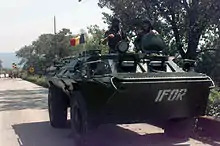
The 1995 NATO bombing of Bosnia and Herzegovina targeted the Bosnian Serb Army and together with international pressure led to the resolution of the Bosnian War and the signing of the Dayton Agreement in 1995. Since then, NATO has led the Implementation Force and Stabilization Force, and other peacekeeping efforts in the country. Bosnia and Herzegovina joined the Partnership for Peace in 2006, and signed an agreement on security cooperation in March 2007.[82]
Bosnia and Herzegovina began further cooperation with NATO within their Individual Partnership Action Plan in January 2008.[75] The country then started the process of Intensified Dialogue at the 2008 Bucharest summit.[76] The country was invited to join the Adriatic Charter of NATO aspirants in September 2008.[83]
The Federation of Bosnia and Herzegovina within Bosnia and Herzegovina has expressed willingness to join NATO, however, it faces consistent political pressure from Republika Srpska, the other political entity in the country, alongside its partners in Russia. On 2 October 2009, Haris Silajdžić, the Bosniak Member of the Presidency, announced official application for Membership Action Plan. On 22 April 2010, NATO agreed to launch the Membership Action Plan for Bosnia and Herzegovina, but with certain conditions attached.[78] Turkey is thought to be the biggest supporter of Bosnian membership, and heavily influenced the decision.[84]
The conditions of the MAP, however, stipulated that no Annual National Programme could be launched until 63 military facilities are transferred from Bosnia's political divisions to the central government, which is one of the conditions for the OHR closure.[85][86] The leadership of the Republika Srpska has opposed this transfer as a loss of autonomy.[87] All movable property, including all weapons and other army equipment, is fully registered as the property of the country starting 1 January 2006.[88] A ruling of the Constitutional Court of Bosnia and Herzegovina on 6 August 2017 decided that a disputed military facility in Han Pijesak is to be registered as property of Bosnia and Herzegovina. It is expected to be a precedent for all other similar facilities, and could thus be the final factor that will enable the activation of the MAP for Bosnia.[89] Despite that all immovable property is not fully registered, NATO approved the activation of the Membership Action Plan for Bosnia and Herzegovina, and called on Bosnia to submit an Annual National Program on 5 December 2018.[90]
An August 2010 poll showed that 70 percent of the country supports NATO membership, but results were very different in the two constituent entities. While 90 percent of the Federation of Bosnia and Herzegovina supported NATO membership, only 40 percent in Republika Srpska did.[91]
Bosnian chances of joining NATO may depend on Serbia's attitude towards the alliance, since the leadership of Republika Srpska might be reluctant to go against Serbian interests.[92] In October 2017, the National Assembly of the Republika Srpska passed a nonbinding resolution opposing NATO membership for Bosnia and Herzegovina.[93]
Georgia

Georgia moved quickly following the Rose Revolution in 2003 to seek closer ties with NATO. Georgia's northern neighbor, Russia, opposed the closer ties, including those expressed at the 2008 Bucharest summit where NATO members promised that Georgia would eventually join the organization.[94]
Complications in the relationship between NATO and Georgia includes the presence of Russian military forces in internationally recognized Georgian territory as a result of multiple recent conflicts, like the 2008 Russo-Georgian War over the territories of Abkhazia and South Ossetia, both of which are home to a large number of citizens of the Russian Federation. On 21 November 2011, Russian President Dmitry Medvedev while addressing soldiers in Vladikavkaz near the Georgian border stated that Russia's 2008 invasion had prevented any further NATO enlargement into the former Soviet sphere.[94]
A nonbinding referendum in 2008 resulted in 73 percent of voters supporting NATO accession. In May 2013, Georgian Prime Minister Bidzina Ivanishvili stated that his goal was to get a Membership Action Plan (MAP) for his country from NATO in 2014.[95] In June 2014, diplomats from NATO suggested that while a MAP was unlikely, a package of "reinforced cooperation" agreements was a possible compromise.[96] Anders Fogh Rasmussen confirmed that this could include the building of military capabilities and armed forces training.[97]
In September 2019, Russian Foreign Minister Sergey Lavrov said that "NATO approaching our borders is a threat to Russia."[98] He was quoted as saying that if NATO accepts Georgian membership with the article on collective defense covering only Tbilisi-administered territory (i.e., excluding the Georgian territories of Abkhazia and South Ossetia, both of which are currently an unrecognized breakaway republics supported by Russia), "we will not start a war, but such conduct will undermine our relations with NATO and with countries who are eager to enter the alliance."[99]
On 29 September 2020, NATO Secretary General Jens Stoltenberg called on Georgia to use every opportunity to move closer to the Alliance and speed up preparations for membership. Stoltenberg stressed that earlier this year, the Allies agreed to further strengthen the NATO-Georgia partnership. According to him, NATO welcomes the progress made by Georgia in carrying out reforms, modernizing its armed forces and strengthening democracy. It is worth noting that so far Georgia's calls for membership in such formulations have not appeared in the rhetoric of the Secretary General of the Alliance. At the same time, NATO recognizes Georgia's aspirations for membership in the Alliance, as in the case of Ukraine.[100]
Ukraine
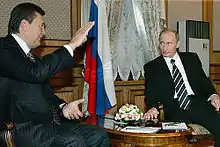
Ukraine's present and future relationship with NATO has been politically divisive, and is part of a larger debate between Ukraine's political and cultural ties to both the European Union and Russia. It established ties to the alliance with a NATO–Ukraine Action Plan on 22 November 2002,[80][101] and joined NATO's Partnership for Peace initiative in February 2005.[102] Then in April 2005, Ukraine entered into the Intensified Dialogue programme with NATO.[103]
In March 2008, under Ukrainian President Viktor Yushchenko and Prime Minister Yulia Tymoshenko, Ukraine sent an official letter of application for a Membership Action Plan (MAP), the first step in joining NATO. These leaders however guaranteed their opposition that membership in any military alliance would not pass without public approval in a referendum.[104] This idea had gained support from a number of NATO leaders, particularly those in Central and Eastern Europe.[105] Russian leaders like Prime Minister and President-Elect Dmitry Medvedev made clear their opposition to Ukraine membership, and leading up to the April 2008 Bucharest summit their emissary actively lobbied against a Ukrainian MAP. After some debate among members at the summit, NATO Secretary General Jaap de Hoop Scheffer declared in a press conference that Ukraine, together with Georgia, would someday join NATO, but neither would begin Membership Action Plans.[106] At this summit, Russian President Vladimir Putin, in his last international speech before switching jobs with Medvedev, listed his grievances with NATO, and called Ukrainian membership "a direct threat" to his country.[107]
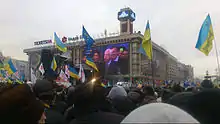
The 2010 election returned Viktor Yanukovych to the presidency and marked a turnaround in Ukraine's relations with NATO. In February 2010, he stated that Ukraine's relations with NATO were currently "well-defined", and that there was "no question of Ukraine joining NATO". He said the issue of Ukrainian membership of NATO might "emerge at some point, but we will not see it in the immediate future".[108] While visiting Brussels in March 2010, he further stated that there would be no change to Ukraine's status as a member of the alliance's outreach programme.[109] He later reiterated during a trip to Moscow that Ukraine would remain a "European, non-aligned state".[110][111] Then, on 3 June 2010 the Ukrainian parliament voted to exclude the goal of "integration into Euro-Atlantic security and NATO membership" from the country's national security strategy in a bill drafted by Yanukovych himself.[112] The bill forbade Ukraine's membership in any military bloc, but allowed for co-operation with alliances such as NATO.[113]
.jpg.webp)
Following months of Euromaidan street protests that began because of his refusal to sign an Association Agreement with the European Union in favor of deals from Russia, President Yanukovych fled Kyiv in February 2014, ultimately to Russia, and parliament voted to remove him from his post. This brought another change in direction of Ukraine's association with Europe and by extension NATO. In 2014, pro-Russian unrest occurred in eastern Ukraine and Crimea was annexed by the Russian Federation in March. As part of an effort to assuage concerned groups, newly installed Prime Minister Arseniy Yatsenyuk addressed the topic in a speech on 18 March 2014, emphasizing that Ukraine was not seeking NATO membership.[114] US President Barack Obama echoed this position the following week, while calling for greater NATO presence in Eastern Europe.[115]
However, in response to the Russian military intervention in Ukraine,[116] Yatsenyuk announced his intentions to resume the bid for NATO integration on 29 August 2014,[117] and in December 2014, Ukraine's parliament voted to drop the non-aligned status that it adopted in 2010.[118] NATO Secretary General Anders Fogh Rasmussen has stated that NATO membership is still an option for Ukraine,[119] and support for NATO membership has risen to 64 percent in government-controlled Ukraine according to a July 2015 poll.[120] Previous polls had shown that the decline in opposition to membership was linked to the ongoing Russian intervention.[121]
On 8 June 2017, Ukraine's Verkhovna Rada passed a law making integration with NATO a foreign policy priority.[122] In July 2017 Poroshenko announced that he would seek the opening of negotiations on a Membership Action Plan with NATO.[123]
By March 2018, NATO had recognized Ukraine as an aspirant country.[72]
On 20 September 2018, the Ukrainian parliament approved amendments to the constitution that would make the accession of the country to NATO and the EU a central goal and the main foreign policy objective.[124]
On 8 October 2020, during a meeting with Prime Minister Boris Johnson in London, President Volodymyr Zelenskyi stated that Ukraine needs a NATO Membership Action Plan, as NATO membership will contribute to Ukraine's security and defense.[125]
Membership debates
Finland
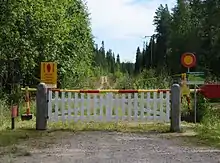
Finland participates in nearly all sub-areas of the Partnership for Peace programme, and has provided peacekeeping forces to both the Afghanistan and Kosovo missions. The possibility of Finland's membership in NATO was one of the most important issues debated in relation to the Finnish presidential election of 2006, and continues to be a significant issue in Finnish politics.[127] In 2007, Finland made various technical preparations for membership, with the then Defence Minister Jyri Häkämies eager to pursue NATO membership.[128] Nevertheless, public interest in the issue has since decreased. In April 2014, while Carl Haglund was Defence Minister, the government announced that they would sign a "Memorandum of Understanding" with NATO on Finland's readiness to receive military assistance and to aid NATO in equipment maintenance. However, Haglund emphasized that this memorandum would not be a step towards membership.[129]
Out of the major Finnish political parties, the National Coalition Party and Swedish People's Party of Finland support NATO membership. In 2016, the party conference of the National Coalition Party agreed that Finland should apply for membership "in the next few years".[130] In the vision of the Swedish People's Party of Finland, Finland will be a NATO member in 2025.[131] Many individual politicians have advocated for NATO as well, including the current President Sauli Niinistö and former Prime Minister Alexander Stubb,[132] as well as former President Martti Ahtisaari,[127][133] who has argued that Finland should join all the organizations supported by other Western democracies in order "to shrug off once and for all the burden of Finlandization."[134] Two other former presidents from the Social Democratic Party, Tarja Halonen and Mauno Koivisto, have publicly opposed the idea, arguing that NATO membership would deteriorate Finland's relations with Russia.[135]
Finland has received some very critical feedback from Russia for even considering the possibility of joining NATO,[136] with a 2009 study suggesting this could have repercussions for Russia's relations with the EU and NATO as a whole.[137] Following the 2008 Russo-Georgian War, Finnish Prime Minister Matti Vanhanen reiterated that Finland had no plans to join NATO, and stated that the main lesson of the war was the need for closer ties to Russia.[138] In a June 2014 interview in the Finnish newspaper Hufvudstadsbladet, Vladimir Putin's personal envoy Sergey Alexandrovich Markov accused Finland of extreme "Russophobia" and suggested that Finland joining NATO could start World War III.[139] In July 2016, Putin stated on a visit to Finland that Russia would increase the number of troops on the Finnish border if Finland were to join NATO. He also warned that NATO would "fight to the last Finn against Russia".[140][141]
A survey conducted by Finnish pollster EVA in January 2015 found that 43 percent of Finns polled opposed NATO membership, while 26 percent supported and 32 percent were undecided. EVA has noted a downward trend in the percent opposed that started in 1998, including a steep decline after the 2012 presidential election.[142] In March 2014, during Russia's annexation of Crimea, one survey showed only 22 percent supported membership, though a second showed that 53 percent would support membership if Finnish leadership recommended it.[143] Support for a military alliance with neighbor Sweden was also high, at 54 percent,[144] and Finland could possibly seek an enlarged role for NORDEFCO.[145] Finnish Minister of Defence Carl Haglund suggested that a referendum on NATO membership could be held sometime after the 2015 parliamentary election.[146] A poll from October 2017 showed that support for membership remained at 22%, while rising to 33% in the suggested scenario in which Sweden would join.[147] The newest poll from December 2019 showed support decreasing further to 20%, while 56% opposed joining the alliance and 24% were unsure.[148]
Ireland

Ireland has been a member of NATO's Partnership for Peace (PfP) programme and Euro-Atlantic Partnership Council (EAPC) since 1999, but has a traditional policy of military neutrality.[150] Ireland participates in the alliance's PfP Planning and Review Process (PARP), which aims to increase the interoperability of the Irish military, the Defence Forces, with other NATO member states and bring them into line with accepted international standards so as to successfully deploy with other professional military forces on peacekeeping operations overseas.[151] Ireland supplied a small number of troops to the NATO-led International Security Assistance Force (ISAF) in Afghanistan (2001–2014) and supports the ongoing NATO-led Kosovo Force (KFOR).[152][153]
Currently no major political party in Ireland fully supports ascension into NATO, a reflection on public and media opinion in the country.[154] There are a number of politicians who do support Ireland joining NATO, mainly within the centre-right Fine Gael party, but the majority of politicians still do not.[155][156] The nationalist party Sinn Féin proposed a constitutional amendment to prohibit the country from joining a military alliance like NATO, but the legislation failed to pass the Dáil Éireann in April 2019.[157][158] It is widely understood that a referendum would have to be held before any changes could be made to neutrality or to joining NATO.[159] Former Secretary General of NATO Anders Fogh Rasmussen said during a visit to the country in 2013 that the "door is open" for Ireland to join NATO at any time.[160]
Moldova
Moldova's constitution forbids the country from joining a military alliance, but some politicians, such as former Moldovan Minister of Defence Vitalie Marinuța, have suggested joining NATO as part of a larger European integration. Moldova joined NATO's Partnership for Peace in 1994, and initiated an Individual Partnership Action Plan in 2010.[161] Following the 2014 annexation of Crimea by Russia, NATO officials warned that Russia might seek to annex Transnistria, a breakaway Moldovan region.[162] This separatist issue could preclude Moldova from joining NATO.[161]
Serbia
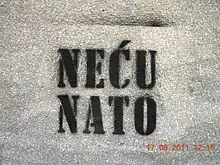
The NATO intervention in Bosnia and Herzegovina in 1992 and the NATO bombing of Yugoslavia in 1999 resulted in strained relations between Serbia and NATO. Relations were further strained following Kosovo's declaration of independence in 2008 while a protectorate of the United Nations with security support from NATO. However, Serbia was invited and joined the Partnership for Peace programme during the 2006 Riga summit and in 2008, was invited to enter the intensified dialogue programme whenever the country is ready.[70]
Serbia's Parliament passed a resolution in 2007 which declared their military neutrality until such time as a referendum was held on the issue.[163] On 1 October 2008, Serbian Defence Minister Dragan Šutanovac signed the Information Exchange Agreement with NATO, one of the prerequisites for fuller membership in the Partnership for Peace programme.[164] In April 2011 Serbia's request for an IPAP was approved by NATO,[165] and Serbia submitted a draft IPAP in May 2013.[166] The agreement was finalized on 15 January 2015.[167]
A CeSID poll in June 2015 conducted with the support of the United States Agency for International Development (USAID) indicated that only 12 percent of those polled supported for NATO membership, down from 25 percent in 2012, and 73 percent were opposed.[168] The minor Liberal Democratic Party and Serbian Renewal Movement remain the most vocal political parties in favor of NATO membership.[169] Although Serbia aspires to join the European Union, Serbia may seek to maintain military neutrality, joining neither NATO or the Collective Security Treaty Organization (CSTO).[92][170]
Sweden
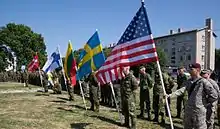
In 1949, Sweden chose not to join NATO and declared a security policy aiming for non-alignment in peace and neutrality in war.[171] A modified version now qualifies non-alignment in peace for possible neutrality in war. This position was maintained without much discussion during the Cold War. Since the 1990s, however, there has been an active debate in Sweden on the question of NATO membership in the post–Cold War world.[172] These ideological divides were visible in November 2006 when Sweden could either buy two new transport planes or join NATO's plane pool, and in December 2006, when Sweden was invited to join the NATO Response Force.[173][174] Sweden has been an active participant in NATO-led missions in Bosnia (IFOR and SFOR), Kosovo (KFOR), Afghanistan (ISAF), and Libya (Operation Unified Protector).[175]
The ruling Swedish Social Democratic Party have remained in favour of neutrality and non-alignment.[176] This preference is shared by their partners, the Green Party, as well as the Left Party. The centre-right Moderate Party is the largest party by current parliamentary representation in favor of NATO membership, and like the Liberal Party have generally held that position since the end of the Cold War.[177] The Centre Party was opposed to NATO membership until September 2015, when party leadership under Annie Lööf announced that they would motion to change the party policy in order to push for Sweden to join NATO at their next party conference. The Christian Democrats, also previously opposed, likewise voted to support NATO membership at their October 2015 party meeting.[178] When the nationalist Sweden Democrats adjusted their stance in December 2020 to allow for NATO membership if coordinated with neighboring Finland and ratified in a referendum, a majority of the members of the Swedish Riksdag for the first time belonged to parties that were open to NATO membership,[179] and a motion to allow for future NATO membership passed the parliament that month by 204 votes to 145.[180]
Ipsos has conducted regular polling, and they have documented a decline in the opposition to membership from 56% in April 2015 to 35% in December 2020, when their poll showed a three-way split among Swedes, with 33% supporting NATO membership and 32% undecided on the issue. The decline largely corresponds to an increase in undecideds, as the percent of Swedes who support NATO membership has stayed mostly steady since 2014.[181] Support for NATO membership previously rose between 2012 and 2015, when the SOM Institute showed it growing from 17% to 31%.[182] Events like the annexation of Crimea and reports of Russian submarine activity in 2014, as well as a 2013 report that Sweden could hold out for only a week if attacked were credited with that rise in support.[183] A May 2017 poll by Pew also showed that 48% supported membership, and in November 2020, they showed that 65% of Swedes viewed NATO positively, the highest percent of any non-NATO member polled.[184]
Other countries
Austria and Switzerland are both members of the Partnership for Peace, and border NATO member states. Malta is also a member of the Partnership for Peace and the European Union.[186] However, each country has a long-standing policy of neutrality. Cyprus is the only member state of the European Union that is not a member of the Partnership for Peace, with any treaty blocked by Turkey's concerns regarding the Cyprus dispute.[187]
According to Minister of Foreign Affairs Enver Hoxhaj, integration with NATO is a priority for Kosovo, which declared independence from Serbia in 2008.[188] Hoxhaj stated in 2014 that the country's goal is to be a NATO member by 2022.[189] However, four NATO member states—Greece, Romania, Spain, and Slovakia—do not recognize Kosovo's independence.[190] United Nations membership, which Kosovo does not have, is considered to be necessary for NATO membership.[191] In December 2018, the Kosovar Prime Minister Ramush Haradinaj stated that Kosovo will apply for NATO membership after the formation of the Kosovo Armed Forces.[192]
Russia, Armenia, Belarus, and Kazakhstan are all members of the Collective Security Treaty Organization (CSTO), an alternative military alliance. In 2009, Russian envoy Dmitry Rogozin did not rule out joining NATO at some point, but stated that Russia was currently more interested in leading a coalition as a great power.[193] Azerbaijan has committed to a policy of neutrality, but has not ruled out eventually joining NATO.[194]
Some individuals have proposed expanding NATO outside of Europe, although doing so would require amending Article 10 of the North Atlantic Treaty.[195] Christopher Sands of the Hudson Institute proposed Mexican membership of NATO in order to enhance NATO cooperation with Mexico and develop a "North American pillar" for regional security.[196] In June 2013, Colombian President Juan Manuel Santos stated his hope that Colombia's cooperation with NATO could result in NATO membership, though his Foreign Minister, Juan Carlos Pinzon, quickly clarified that Colombia is not actively seeking NATO membership.[197] Ivo Daalder and James Goldgeier proposed a "global NATO" that would incorporate democratic states from around the world, including Australia, New Zealand, Japan, South Korea, Brazil, South Africa, and India,[195] while Republican presidential candidate Rudy Giuliani suggested expanding NATO to include Singapore, Israel, Australia, India, and Japan.[198]
On 20 March 2019, US president, Donald Trump said he would make Brazil a major non-NATO ally at a meeting with Brazilian President, Jair Bolsonaro at the White House. During a joint press conference, President Trump expressed support for the eventual ascension of Brazil into NATO.[199] France however has rejected the proposal claiming Article 10 of the treaty limits geography of membership to European countries.[200]
Internal enlargement is the process of new member states arising from the break-up of or secession from an existing member state. There have been and are a number of active separatist movements within member states. The Scottish National Party agreed at its conference in 2012 that it wished for Scotland to retain its NATO membership were it to become independent from the United Kingdom.
On 9 January 2020, Donald Trump mentioned that the alliance should expand into the Middle East to countries like Israel, Jordan, Egypt, and Kuwait among others.[201]
See also
Further reading
- Sergey Radchenko (2020) "‘Nothing but humiliation for Russia’: Moscow and NATO’s eastern enlargement, 1993-1995." Journal of Strategic Studies.
References
- Ghosh, Palash (26 June 2012). "Why Is Turkey in NATO?". The International Business Times. Retrieved 13 September 2014.
- Haftendorn, Helga (Summer 2005). "Germany's accession to NATO: 50 years on". NATO Review. Retrieved 13 September 2014.
- Magone 2009, p. 439.
- Magone 2009, pp. 385–386.
- Sarotte, Mary Elise (September–October 2014). "A Broken Promise?". Foreign Affairs. Retrieved 28 August 2014.
- Kramer, Mark; Shifrinson, Joshua R. Itzkowitz (1 July 2017). "NATO Enlargement—Was There a Promise?". International Security. 42 (1): 186–192. doi:10.1162/isec_c_00287. ISSN 0162-2889. S2CID 57571871.
- "Deal or No Deal? The End of the Cold War and the U.S. Offer to Limit NATO Expansion". doi:10.1162/ISEC_a_00236.
- Kramer, Mark (1 April 2009). "The Myth of a No-NATO-Enlargement Pledge to Russia". The Washington Quarterly. 32 (2): 39–61. doi:10.1080/01636600902773248. ISSN 0163-660X. S2CID 154322506.
- Trachtenberg, Marc. "The United States and the NATO Non-extension Assurances of 1990:New Light on an Old Problem?" (PDF).
- "NATO Expansion: What Gorbachev Heard | National Security Archive". nsarchive.gwu.edu. Retrieved 12 December 2017.
- "When Washington Assured Russia NATO Would Not Expand |".
- "20 lat temu Polska wstąpiła do NATO. "Wysiłki dwóch prezydentów i siedmiu premierów"". TVN24. Retrieved 22 May 2020.
- Klussmann, Uwe; Schepp, Matthias; Wiegrefe, Klaus (26 November 2009). "NATO's Eastward Expansion: Did the West Break Its Promise to Moscow?". Spiegel Online. Retrieved 7 April 2014.
- Gorbachev 1996, p. 675.
- Blomfield A and Smith M (6 May 2009). "Gorbachev: US could start new Cold War". The Telegraph. Paris. Retrieved 22 May 2009.
- Pifer, Steven. "Did NATO Promise Not to Enlarge? Gorbachev Says "No"". Brookings. Retrieved 11 September 2017.
- Zoellick, Robert B. (22 September 2000). "The Lessons of German Unification". The National Interest.
- "Irony Amid the Menace". CEPA. Retrieved 27 May 2020.
- Murphy, Dean E. (14 January 1995). "Chechnya Summons Uneasy Memories in Former East Bloc". The Los Angeles Times. ISSN 0458-3035. Retrieved 22 November 2015.
- Barany 2003, pp. 190, 48–50.
- Perlez, Jane (17 November 1997). "Hungarians Approve NATO Membership". The New York Times. Retrieved 4 December 2014.
- "W przeddzień wstąpienia do NATO" (PDF). CBOS. 1999.
- David & Levesque 1999, p. 200–201.
- Gheciu 2005, p. 72.
- Barany 2003, pp. 23–25.
- Barany 2003, pp. 16–18.
- Epstein, Rachel (2006). "Nato Enlargement and the Spread of Democracy: Evidence and Expectations". Security Studies. 14: 63–105. doi:10.1080/09636410591002509. S2CID 143878355.
- Shifrinson, Joshua R. (2020). "NATO enlargement and US foreign policy: the origins, durability, and impact of an idea". International Politics. 57 (3): 342–370. doi:10.1057/s41311-020-00224-w. hdl:2144/41811. ISSN 1740-3898. S2CID 216168498.
- Shifrinson, Joshua R. Itzkowitz (1 April 2020). "Eastbound and down:The United States, NATO enlargement, and suppressing the Soviet and Western European alternatives, 1990–1992". Journal of Strategic Studies. 0 (6–7): 816–846. doi:10.1080/01402390.2020.1737931. ISSN 0140-2390. S2CID 216409925.
- Sarotte, M.E. (1 July 2019). "How to Enlarge NATO: The Debate inside the Clinton Administration, 1993–95". International Security. 44 (1): 7–41. doi:10.1162/isec_a_00353. ISSN 0162-2889. S2CID 198952372.
- Wolchik & Curry 2011, p. 148.
- Peter, Laurence (2 September 2014). "Why Nato-Russia relations soured before Ukraine". BBC News. Retrieved 1 October 2014.
- Umland, Andreas (2016). "Intermarium: The Case for Security Pact of the Countries between the Baltic and Black Seas". IndraStra Global. 2 (4): 2.
- "No Smoking Law, Alcohol Limit-Yes, Referendum-No". Dalje. 4 January 2008. Archived from the original on 9 January 2015. Retrieved 9 January 2015.
- Bilefsky, Dan (22 March 2009). "Slovenia Border Spat Imperils Croatia's NATO Bid". The New York Times. Retrieved 9 January 2015.
- "Slovenia Ratifies Croatia's Accession in NATO". Dalje. 9 February 2008. Archived from the original on 9 January 2015. Retrieved 9 January 2015.
- "Albania, Croatia become NATO members". NBC News. Associated Press. 1 April 2009. Retrieved 9 January 2015.
- "Montenegro Hands over Application for NATO's MAP". Turkish Weekly. MIA. 6 November 2008. Archived from the original on 9 February 2015. Retrieved 9 February 2015.
- "Montenegro Joins NATO Membership Action Plan". 4 December 2009. Retrieved 4 December 2009.
- "Development of relations between Montenegro and NATO – key dates". Ministry of Foreign Affairs and European Integration. 2013. Archived from the original on 16 March 2016. Retrieved 5 June 2015.
- "NATO's relations with Montenegro". NATO. 19 November 2014. Retrieved 9 February 2015.
- Emmott, Robin; Siebold, Sabine (2 December 2015). "NATO invites Montenegro to join alliance, defying Russia". Reuters. Retrieved 2 December 2015.
- Dahlburg, John-Thor; Lee, Matthew (19 May 2016). "NATO formally invites Montenegro as 29th member". Associated Press. Archived from the original on 21 May 2016. Retrieved 19 May 2016.
- "Montenegro becomes NATO's 29th member amid bitter opposition from Moscow". The Japan Times. AFP-JIJI. 5 June 2017. Retrieved 5 June 2017.
- Lungescu, Oana (2 April 2008). "Nato Macedonia veto stokes tension". BBC News. Retrieved 12 May 2008.
- Thiele 2005, pp. 73–74.
- "NATO invites Macedonia to begin membership talks, says it can join once name issue is resolved". ABC News. 11 July 2019. Archived from the original on 11 July 2018. Retrieved 11 July 2018.
- "Formal Accession Talks with Skopje begin at NATO Headquarters". NATO. 8 October 2018. Retrieved 8 October 2018.
- "Macedonia signs Nato accession agreement". BBC. 6 February 2019. Retrieved 6 February 2019.
- "NATO door open to North Macedonia after Spain's approval". Daily Sabah. German Press Agency. 17 March 2020. Retrieved 19 March 2020.
- "North Macedonia Parliament Backs NATO Accession". The New York Times. Associated Press. 11 February 2020. Retrieved 17 February 2020.
- "North Macedonia joins NATO as 30th Ally". NATO. 27 March 2020.
- "North Macedonia Joins the NATO Alliance". U.S. Department of State. 27 March 2020.
- . 1949 – via Wikisource.
- "Fogh in the Aegean". The Economist. 10 September 2009. Retrieved 11 December 2011.
- Trifunovska 2010, pp. 36–37
- Frappi & Carati 2009, p. 50.
- Marshall, Andrew (8 February 1995). "Transatlantic rift haunts Nato". Retrieved 30 December 2014.
- Trifunovska 1996, pp. 16–17.
- Pifer, Steven (2 July 2014). "Putin's NATO Fears Are Groundless". The Moscow Times. Retrieved 29 December 2014.
- "Membership Action Plan (MAP)". NATO (Press release). 24 April 1999. NAC-S(99)66. Retrieved 5 February 2015.
- "NATO enlargement". NATO Topics. 12 June 2014. Archived from the original on 6 February 2015. Retrieved 29 December 2014.
- Bigg, Claire (2 April 2008). "NATO: What Is A Membership Action Plan?". Radio Free Europe/Radio Liberty. Retrieved 6 February 2015.
- "Membership Action Plan (MAP)". NATO. 18 February 2019. Retrieved 29 January 2020.
- "The Road to NATO membership". NATO. 21 September 2007. Retrieved 14 September 2008.
- "NATO Press Release M-NAC-2 (97)155". www.nato.int. Retrieved 27 September 2020.
- "NATO offers Intensified Dialogue to Georgia". NATO. 21 September 2006.
- Giragosian, Richard (31 July 2006). "Georgia: Kodori Operation Raises NATO Questions". Radio Free Europe/Radio Liberty. Retrieved 5 February 2015.
- Vucheva, Elitsa (4 April 2008). "France signals full return to NATO". EUobserver. Retrieved 6 February 2015.
- "NATO offers "intensified dialogue" to Serbia". B92. 3 April 2008. Retrieved 20 September 2008.
- "Russia says Georgia's entry to NATO could lead to war". The Atlantic Council. RIA Novosti. 9 December 2011. Retrieved 30 December 2014.
- "Enlargement". NATO. 9 March 2018. Retrieved 10 March 2018.
- "Signatures of Partnership for Peace Framework Document". NATO. 10 January 2012. Retrieved 9 February 2015.
- "Individual Partnership Action Plans". NATO. Retrieved 13 November 2013.
- "NATO's relations with Bosnia and Herzegovina". NATO. 17 June 2014. Retrieved 5 June 2015.
- "Nato Macedonia veto stokes tension". BBC News. 4 April 2008. Retrieved 5 February 2015.
- "NATO Approves Membership Action Plan for Bosnia". balkaninsight.com.
- "Bosnia gets Nato membership plan". BBC News. 22 April 2010. Retrieved 22 April 2010.
- "NATO Grants 'Intensified Dialogue' to Georgia". Civil Georgia. 21 September 2006. Retrieved 15 September 2008.
- "NATO-Ukraine Action Plan". NATO. 22 November 2002. Retrieved 11 November 2013.
- "NATO launches 'Intensified Dialogue' with Ukraine". NATO Update. 21 April 2005. Retrieved 21 April 2005.
- "Bosnia, NATO sign security deal". B92. 19 March 2007. Retrieved 22 September 2008.
- "Adriatic Charter Fact Sheet". Bureau of European and Eurasian Affairs. U.S. Department of State. 25 August 2011. Retrieved 5 June 2015.
- Sarić, Lejla (23 April 2010). "BiH dobila zeleno svjetlo za MAP" (in Bosnian). Retrieved 6 February 2015.
- "Bosnia and Herzegovina and Membership Action Plan". NATO. 22 April 2010. Retrieved 17 November 2013.
- "NATO rules out admitting new members anytime soon". Fox News. Associated Press. 5 July 2014. Retrieved 6 February 2015.
- Pop, Valentina (23 April 2010). "Nato grants Bosnia pre-membership status". EUobserver. Retrieved 6 February 2015.
- Law on Defence of Bosnia and Herzegovina (PDF). Archived from the original (PDF) on 3 April 2018. Retrieved 6 December 2018.
- Kovacevic, Danijel (16 August 2017). "Court Rejects Bosnian Serb Claim to Army Facilities". Retrieved 18 August 2017.
- Lakic, Mladen (5 December 2018). "NATO Approves Membership Action Plan for Bosnia". Balkan Insight. Retrieved 5 December 2018.
- "Public Opinion Poll Bosnia and Herzegovina" (PDF). National Democratic Institute. August 2010. p. 35. Retrieved 25 June 2014.
- "Bosnia's NATO hopes 'depend on Serbia'". The Journal of Turkish Weekly. 27 March 2014. Archived from the original on 28 March 2014. Retrieved 28 March 2014.
- "Bosnian Serbs pass resolution against NATO membership". The Washington Post. Associated Press. 18 October 2017. Retrieved 18 October 2017.
- "Russia says Georgia war stopped NATO expansion". Reuters. 21 November 2011.
- Kucera, Joshua (2 May 2013). "Ivanishvili: We Will Get NATO MAP in 2014". Retrieved 17 August 2013.
- Croft, Adrian (20 June 2014). "NATO unlikely to grant Georgia step to membership: diplomats". Reuters. Retrieved 20 June 2014.
- Croft, Adrian (25 June 2014). "NATO will not offer Georgia membership step, avoiding Russia clash". Reuters. Retrieved 25 June 2014.
- "Lavrov: If Georgia Joins NATO, Relations Will Be Spoiled". Georgia Today. 26 September 2019.
- "Russian FM Lavrov supports resumption of flights to Georgia as Georgians 'realised consequences' of June 20". Agenda.ge. 26 September 2019. Retrieved 29 September 2019.
- https://www.eurointegration.com.ua/news/2020/09/29/7114813/
- "NATO's relations with Ukraine". NATO. 16 December 2014. Retrieved 9 February 2015.
- Yekelchyk 2007, p. 202.
- "NATO launches 'Intensified Dialogue' with Ukraine". NATO. 20 April 2005.
- "Ukraine will not join NATO without referendum". GlobalSecurity. 5 (173). 19 January 2008. Retrieved 20 September 2008.
- Ďurianová, Marta (20 March 2006). "President Gašparovič meets Ukrainian Foreign Affairs Minister". The Slovak Spectator. Retrieved 20 September 2008.
- Ambrosio 2013, pp. 150–154.
- Erlanger, Steven (5 April 2008). "Putin, at NATO Meeting, Curbs Combative Rhetoric". The New York Times. Retrieved 27 March 2014.
- Yanukovych opens door to Russian navy keeping base in Ukraine GlobalSecurity.org Retrieved on 9 March 2010
- "Ukraine's Yanukovych: EU ties a 'key priority'". Kyiv Post. Associated Press. 1 March 2010. Retrieved 7 April 2015.
- "Ukraine vows new page in ties with Russia". The News International. 6 March 2010. Retrieved 9 March 2010.
- "Ukraine drops Nato membership pursuit". The Daily Telegraph. UK. 28 May 2010. Retrieved 7 June 2010.
- Ukraine drops NATO membership bid, EUobserver (6 June 2010)
- Ukraine's parliament votes to abandon Nato ambitions, BBC News (3 June 2010)
- Polityuk, Pavel (18 March 2014). "PM tells Ukrainians: No NATO membership, armed groups to disarm". Reuters. Retrieved 27 March 2014.
- Croft, Adrian; Mason, Jeff (26 March 2014). "Obama says NATO needs to boost presence in eastern Europe". Reuters. Retrieved 27 March 2014.
- "Putin admits Russian forces were deployed to Crimea", Reuters, 17 April 2014,
We had to take unavoidable steps so that events did not develop as they are currently developing in southeast Ukraine. ... Of course our troops stood behind Crimea's self-defence forces.
- "Ukraine to seek Nato membership, says PM Yatsenyuk". BBC News. 9 August 2014. Retrieved 9 February 2015.
- "Ukraine votes to drop non-aligned status". BBC News. 23 December 2014. Retrieved 23 December 2014.
- "Door to NATO remains open for Ukraine". Euronews. 26 February 2014. Retrieved 27 February 2014.
- "Support for joining NATO considerably increases in Ukraine –poll". Interfax-Ukraine. 3 August 2015. Retrieved 4 August 2015.
- Williams, Carol J. (14 May 2014). "Russian aggression driving Ukrainians toward EU, NATO, poll finds". The Los Angeles Times. Retrieved 15 May 2014.
- "Rada restores Ukraine's course for NATO membership as foreign policy priority". Interfax-Ukraine. 8 June 2017. Retrieved 8 June 2017.
- "Pledging reforms by 2020, Ukraine seeks route into NATO". Reuters. 10 July 2017. Retrieved 22 July 2017.
- "Ukraine pushes ahead with plans to secure NATO membership". Associated Press. 20 September 2018. Retrieved 15 October 2018.
- "Zelenskyi said in Britain that Ukraine needed a MAP in NATO".
- Grenfell & Jopling 2008, p. 13.
- Bult, Jeroen (3 March 2006). "Finland Debates Its Ties With NATO". Worldpress. Retrieved 20 September 2008.
- Rettman, Andrew (26 April 2007). "Finland waits for new EU treaty before NATO membership review". EUobserver. Retrieved 20 September 2008.
- "Finland To Sign Memorandum of Understanding With NATO". Finnbay. 22 April 2014. Retrieved 22 April 2014.
- "Kokoomus päätti Nato-linjastaan: Puolustusliittoon lähivuosina". Verkkouutiset. 12 June 2016. Retrieved 12 June 2016.
- "RKP on nyt virallisesti Nato-puolue". Yle. 12 June 2016. Retrieved 12 June 2016.
- Rosendahl, Jussi; Suoninen, Sakari (14 June 2014). "Stubb to be Finland's next PM, backs NATO membership". Reuters. Retrieved 14 June 2014.
- "Ex-President Ahtisaari calls on Finland to join NATO with Sweden". Alaska Dispatch. YLE News. 12 April 2014. Archived from the original on 19 April 2014. Retrieved 18 April 2014.
- "Former President Ahtisaari: NATO membership would put an end to Finlandisation murmurs". Helsingin Sanomat. 15 December 2003. Archived from the original on 5 December 2008. Retrieved 20 September 2008.
- Jakobson, Max (20 January 2004). "Finland, NATO, and Russia". Helsingin Sanomat. Archived from the original on 5 December 2008. Retrieved 20 September 2008.
- "Russian Foreign Minister Lavrov: Finland Wouldn't Dare for NATO Membership". Finnbay. 15 June 2014. Retrieved 15 June 2014.
- "Waking the Neighbour: Finland, NATO and Russia: Keir Giles and Susanna Eskola, UK Defence Academy, November 2009" (PDF).
- Deeper Russia Ties Is Georgia War Lesson, Finnish Premier Says Bloomberg Retrieved on 9 October 2009
- Nilsen, Thomas (9 June 2014). "Putin envoy warns Finland against joining NATO". Barents Observer. Retrieved 9 June 2014.
- "Putin moitti Natoa tiukasti Suomen-vierailullaan". Helsingin Sanomat. 2 July 2016. Retrieved 3 July 2016.
- Putin has toughened up his rhetoric, views expert. helsinkitimes.fi (5 July 2016). Retrieved on 22 July 2016.
- "MEVAn Arvo- ja asennetutkimuksen ennakkotieto: Nato-kannat muuttuneet myönteisemmiksi". Elinkeinoelämän valtuuskunta (in Finnish). 3 February 2015. Retrieved 11 February 2015.
- Schauman, Satu (25 March 2014). "Verkkouutiset selvitti: Kansa valmis Natoon, jos valtiojohto niin haluaa". Verkkouutiset (in Finnish). Retrieved 1 September 2014.
- O'Dwyer, Gerard (26 March 2014). "Majority of Finns Support Swedish Military Alliance". Defense News. Retrieved 27 March 2014.
- Steffen, Sarah (26 March 2014). "NATO next for Sweden and Finland?". DeutscheWelle.
- Suoninen, Sakari; Rosendahl, Jussi (18 June 2014). "Finnish reasons for joining NATO 'stronger than ever': defense minister". Reuters. Retrieved 18 June 2014.
- "HS-gallup: Suomalaiset tyrmäävät Nato-jäsenyyden – mutta onko Suomi jo tiiviimmin Naton kyljessä kuin kansa tajuaakaan?". Helsingin Sanomat. 5 November 2017. Retrieved 5 November 2017.
- "Suomalaisilta yhä selvä ei Nato-jäsenyydelle". Helsingin Sanomat. 15 December 2019. Retrieved 15 December 2019.
- Wade, Jennifer (21 March 2013). "Ireland committed to Partnership for Peace but has no plans to join NATO – Shatter". The Journal. Retrieved 20 February 2016.
- "NATO's 'neutral' European partners: valuable contributors or free riders?". NATO Review Magazine. Retrieved 15 July 2015.
- "Defence Questions: Irish cooperation with NATO in Ukraine". Eoghan Murphy TD. Retrieved 15 July 2015.
- "Current Missions > ISAF". Defence Forces Ireland. Archived from the original on 16 July 2015. Retrieved 15 July 2015.
- "Current Missions > KFOR". Defence Forces Ireland. Retrieved 15 July 2015.
- O'Carroll, Sinead (13 February 2013). "Poll: Should Ireland give up its neutrality?". thejournal.ie. Retrieved 15 July 2015.
- McCullagh, David (19 May 2015). "David McCullagh blogs on Ireland's defence policy". RTÉ Prime Time. Retrieved 18 July 2015.
- Roche, Barry (30 August 2014). "Ireland should change position on military neutrality, says academic". The Irish Times. Retrieved 15 July 2015.
- Mullan, Kevin (9 April 2019). "Martina Anderson calls for Irish neutrality referendum amid fears over European militarisation". Derry Journal. Retrieved 29 January 2020.
- "Thirty-Eighth Amendment of the Constitution (Neutrality) Bill 2018". Houses of the Oireachtas. 11 April 2019. Retrieved 29 January 2020.
- "Challenges and opportunities abroad: White paper on foreign policy" (PDF). Department of Foreign Affairs and Trade Ireland. Retrieved 15 July 2015.
- Lynch, Suzanne (11 February 2013). "Door is open for Ireland to join Nato, says military alliance's chief". The Irish Times. Retrieved 15 July 2015.
- Sanchez, W. Alex (9 January 2013). "Moldova and NATO: Expansion Stops at the Dniester River?". E-International Relations. Retrieved 28 March 2014.
- Morello, Carol (23 March 2014). "NATO general warns of further Russian aggression". The Washington Post. Retrieved 28 March 2014.
- "Serbian parliament's Kosovo resolution". B92. 27 December 2007. Retrieved 17 December 2013.
- "Šutanovac, NATO sign agreement". b92. 1 October 2008. Retrieved 5 June 2015.
- "NATO's relations with Serbia". NATO. 16 January 2015. Archived from the original on 12 November 2013. Retrieved 9 February 2015.
- "Serbia and NATO, are we at a turning point?". Ministry of Foreign Affairs of Serbia. 25 July 2013. Retrieved 11 November 2013.
- "Dacic: IPAP, step forward in Serbia-NATO relations". infoBalkans. Tanjug. 16 January 2015. Retrieved 16 January 2015.
- "Serbia: Only 50 pct of citizens support EU integration, 73 pct against NATO membership". InSerbia. Tanjug. 30 June 2015. Retrieved 23 July 2015.
- Radoman, Jelena (10 December 2010). "NATO-Serbia relations: New strategies or more of the same?". EurActiv. Retrieved 25 June 2014.
- "Swiss envoy: Serbia doesn't need to join NATO". UPI. 26 November 2013. Retrieved 28 March 2014.
- Agius 2006, p. 103–105.
- Agius 2006, p. 142–147.
- "Sweden 'should join NATO plane pool'". The Local. 11 November 2006. Retrieved 20 September 2008.
- "Sweden could join new NATO force". The Local. 2 December 2006. Retrieved 20 September 2008.
- "Sweden: one of NATO's most active and effective partners". NATO. 14 January 2013. Retrieved 9 February 2015.
- "What price neutrality?". The Economist. 21 June 2014. Retrieved 5 May 2015.
- Simpson, Peter Vinthagen; Parafianowicz, Lydia (13 May 2009). "Liberals: Sweden must join NATO". The Local. Retrieved 9 February 2015.
- Ahlander, Johan (9 October 2015). "Swedish centre right in favour of NATO membership". Reuters. Retrieved 10 October 2015.
- "Majority in Swedish parliament backs 'NATO option' after Sweden Democrats shift". Reuters. 9 December 2020. Retrieved 15 December 2020.
- Duxbury, Charlie (22 December 2020). "Sweden edges closer to NATO membership". Politico. Retrieved 11 January 2021.
- Holmström, Mikael (10 January 2021). "DN/Ipsos: Svenskarnas motstånd mot Nato minskar". Dagens Nyheter (in Swedish). Retrieved 11 January 2021.
- "Nearly one-third of Swedes want to join Nato". The Local. 20 May 2015. Retrieved 1 September 2015.
- nato "More Swedes show support for Nato" Check
|url=value (help). The Local. 9 January 2015. Retrieved 1 September 2015. - Fagan, Moira (30 November 2020). "NATO seen in a positive light by many across 10 member states". Pew Research Center's Global Attitudes Project. Retrieved 11 January 2021.
- Smith 2006, pp. 446–448.
- Fsadni, Ranier (25 April 2013). "The meaning of neutrality". Times of Malta. Retrieved 28 March 2014.
- Dempsey, Judy (24 November 2010). "Between the European Union and NATO, Many Walls". The New York Times. Retrieved 28 March 2014.
- "Hoxhaj: Pas anëtarit vëzhgues në Asamblenë Parlamentare të NATO-s, Kosova edhe me ushtri" (in Albanian). Ministry of Foreign Affairs of Kosovo. 24 June 2014. Retrieved 27 July 2015.
- "Hoxhaj në Mitrovicë, Kosova anëtarësohet në NATO para 2022". Ministry of Foreign Affairs of Kosovo. 16 May 2014. Retrieved 16 May 2014.
- "Kosovo question still divides EU". Deutsche Welle. 8 September 2012. Retrieved 5 June 2015.
- "Daily: No NATO membership for Kosovo". 5 February 2013. Retrieved 11 November 2013.
- "Kosovo PM: "After approving army, Kosovo will apply for NATO"". top-channel.tv. Retrieved 8 December 2018.
- "Russia does not rule out future NATO membership". EUobserver. Retrieved 1 May 2009.
- "Azerbaijan not to join NATO". Zee News. 25 May 2013. Retrieved 28 March 2014.
- Daalder, Ivo; James Goldgeier (October 2006). "Global NATO". Foreign Affairs. Retrieved 28 March 2014.
- Sands, Christopher (18 May 2012). "Why NATO Should Accept Mexico". HuffPost. Retrieved 28 March 2014.
- "Colombia Minister Says No to NATO Membership". Fox News. Associated Press. 4 June 2014. Retrieved 25 June 2014.
- Woodroofe, Thom (12 May 2012). "NATO: the Australian experience". ABC. Archived from the original on 19 February 2013. Retrieved 28 March 2014.
- Samuels, Brett (19 March 2019). "Trump suggests admitting Brazil to NATO alliance". The Hill. Retrieved 25 March 2019.
- McGuinness, Romina (21 March 2019). "France rejects Trump demand to give Brazil NATO membership". Express. Retrieved 25 March 2019.
- "Remarks by President Trump on Proposed National Environmental Policy Act Regulations". White House. 9 January 2020. Retrieved 11 January 2020.
Bibliography
- Ambrosio, Thomas (2013). Authoritarian Backlash: Russian Resistance to Democratization in the Former Soviet Union. Ashgate Publishing, Ltd. ISBN 978-1-4094-9889-6.
- Agius, Christine (2006). The social construction of Swedish neutrality: Challenges to Swedish identity and sovereignty. Manchester University Press. ISBN 978-1-84779-199-3.
- Barany, Zoltan (2003). The Future of NATO Expansion: Four Case Studies. Cambridge University Press. ISBN 978-1-139-44044-8.
- David, Charles-Philippe; Levesque, Jacques (1999). Future of NATO: Enlargement, Russia, and European Security. McGill-Queen's Press. ISBN 978-0-7735-6785-6.
- Frappi, Carlo; Carati, Andrea (2009). NATO in the 60th anniversary of the North Atlantic Treaty. FrancoAngeli. ISBN 978-88-568-1977-9.
- Gheciu, Alexandra (2005). NATO in the New Europe: The Politics of International Socialization After the Cold War. Stanford University Press. ISBN 978-0-8047-6766-8.
- Gorbachev, Mikhail (1996). Memoirs. London: Doubleday. ISBN 978-0-385-40668-0.
- Grenfell, Julian; Jopling, Thomas Michael (2008). FRONTEX: the EU external borders agency, 9th report of session 2007–08. House of Lords Stationery Office. ISBN 978-0-10-401232-1.
- Magone, José María (2009). Contemporary Spanish Politics. Taylor & Francis. ISBN 978-0-415-42188-1.
- Smith, Simon C. (2006). Malta: British documents on the end of empire. University of London Institute of Commonwealth Studies. ISBN 978-0-11-290590-5.
- Thiele, Ralph (2005). Mediterranean Security After EU and NATO Enlargement. Rubbettino Editore. ISBN 978-88-498-1037-0.
- Trifunovska, Snežana (1996). The Transatlantic Alliance on the Eve of the New Millennium. Martinus Nijhoff Publishers. ISBN 978-90-411-0243-0.
- Trifunovska, Snežana (2010). North Atlantic Treaty Organization. Kluwer Law International. ISBN 978-90-411-3328-1.
- Wolchik, Sharon L.; Curry, Jane Leftwich (2011). Central and East European Politics: From Communism to Democracy. Rowman & Littlefield. ISBN 978-0-7425-6734-4.
- Yekelchyk, Serhy (2007). Ukraine: Birth of a Modern Nation. Oxford University Press. ISBN 978-0-19-530546-3.
